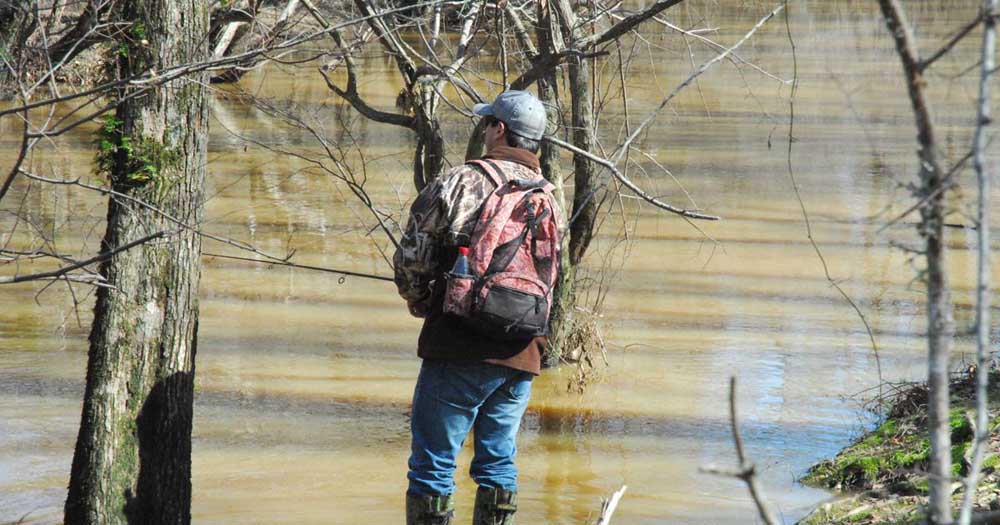On the Run: Spawning season has white bass, fishermen moving to tributaries
Published 10:39 pm Thursday, February 27, 2025

- With flowing water and water temperatures reaching the mid-50s white bass are moving into tributaries and upper ends of reservoirs to spawn. (Steve Knight/Tyler Morning Telegraph)
White bass, or sandies as they are often called, are a popular species for fishermen in Texas, but at this time of year their popularity peaks.
Spots like the Neches River above Lake Palestine can be packed with fishermen taking advantage of the fishes’ spawning run when conditions are right, meaning moving water and water temperatures somewhere around 55 to 65 degrees.
“Many lakes in East Texas offer white bass fishing throughout the year, but most folks focus on the run and leave the rest of the year to other species,” explained Marcos De Jesús, Texas Parks and Wildlife Department Inland Fisheries regional director from Tyler.
De Jesús said the species is especially popular during the run with fishermen wanting to catch fish to eat, young anglers who enjoy the constant action and even fly fishermen.
A prolific species, white bass are native to the Mississippi River drainage. Historically in Texas that meant rivers and lakes within the Red River drainage. However, through time fishermen have introduced the species to other reservoirs from Lake Palestine to lakes in the Panhandle and as far west as the Trans Pecos region.
Most East Texas lakes have the fish, and they are a popular fishery. At some lakes, like Tawakoni and others, they may be more popular than largemouth bass.
“One lake that definitely is a popular white bass destination is Lake Livingston, where 55 percent of total directed angling effort in a year goes towards white bass,” De Jesús said.
De Jesús explained that for a spawning run to be successful several conditions must come together.
“The two biggest environmental factors to trigger white bass spawning and their migratory run up our reservoir’s tributaries are water temp, especially increasing temps, and water flow. I still feel photoperiod and increasing daylight hours have a role in it too, like other species, but temperature and flow are the two big ones. You need both elements to occur simultaneously to really have a strong run,” he said.
De Jesús added, “If water temps start increasing into the mid 50’s and we get some warm rains that bring rising waters and flowing creeks, the white bass will flood into the tributaries so thick you can almost walk across their backs.”
The biologist said white bass males were on the move early last week on the upper Neches, and the females could be starting a major push with the warming temperatures.
“These runs usually peak fast and provide fishing opportunities for three weeks to a month, depending on conditions and whether you consider the run back to the reservoir part of it,” De Jesús said.
Along with the Neches, Kickapoo Creek above Lake Palestine also has foot access.
Going further west, foot access at Chambers Creek off Texas 31 above Richland Chamber Reservoir is also an option.
Other lakes out of the Inland Fisheries district office in Tyler with good white bass populations that are accessible primarily by boat include Cedar Creek, Tawakoni, Fork, Cooper, Tyler and Bardwell.
Out of the Marshall office the best spot is traditionally the Black Shoals area of the Sabine River between the U.S. 59 and FM 1794 boat ramps. However, it can only be accessed by water when the water depth is about 10 feet at the Beckville meter. Big females have already been reported moving into the area.
Another site is Big Cypress Bayou above Lake O’ the Pines and below FM 2231, but with the recent heavy rains this area may not be as productive.
Big Cypress below Pines and the Sulphur River below Wright Patman Reservoir also have good runs and are easily accessible without a boat.
Out of the Jasper office good areas to fish the spawning run are the Sabine River above Toledo Bend Reservoir using the Logansport /Joaquin boat ramp, Yellow Dog ramp in Louisiana and McFadden’s Ferry. Also, the Angelina River at Sam Rayburn launching at Marion’s Ferry or at Hank’s Creek to run upstream can be productive.
From College Station to Houston many of the traditional spots have slowed in recent years because of a lack of flow or low water levels. However, prospects are good above Lake Houston in Peach, Caney and Spring creeks.
While fishermen are locked in on runs, tributaries above lakes are not the only place white bass spawn.
“I ran some studies in central Texas where I observed that some populations have developed a secondary spawning strategy, where droughts are more frequent. Some groups of fish will stay in the main lake to spawn over wind-blown main gravel points while other run,” De Jesús said.
The best thing about white bass fishing is that it does not require as much technic or specialized gear as other species.
“Light gear is the best. A spinning rod and reel with 8-pound test is enough. They hit just about anything that mimics a minnow. Adapt your presentation to the water conditions. Their big eyes suggest they are sight feeders, but the muddy East Texas waters can call for high contrast colors and some noise created by blades or rattles,” De Jesús noted.


